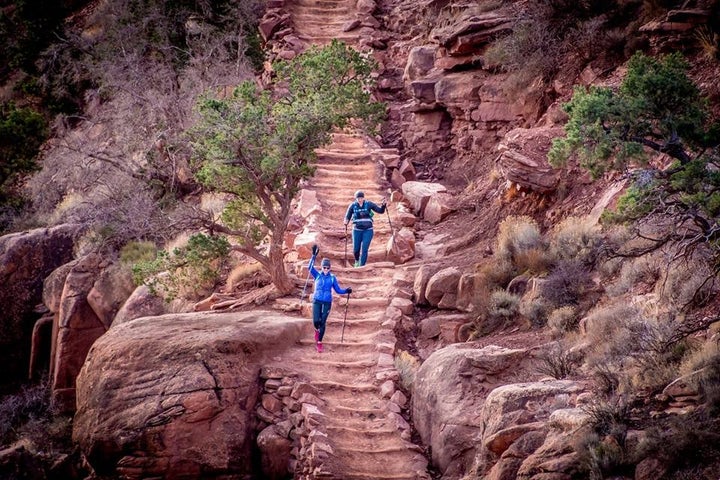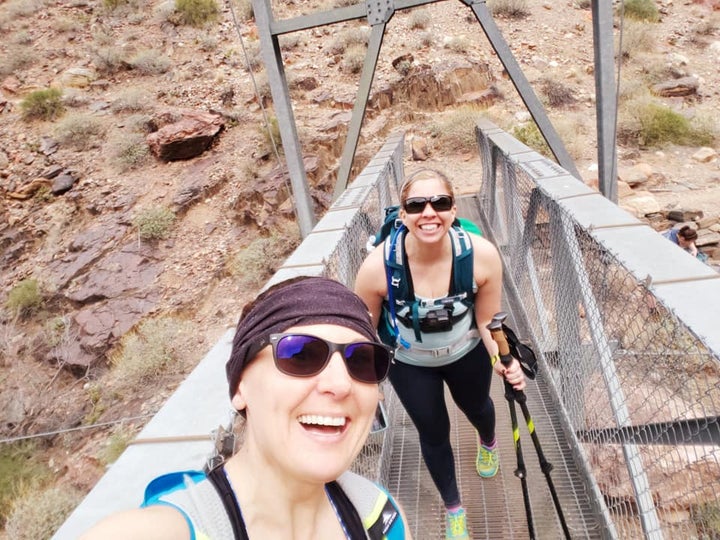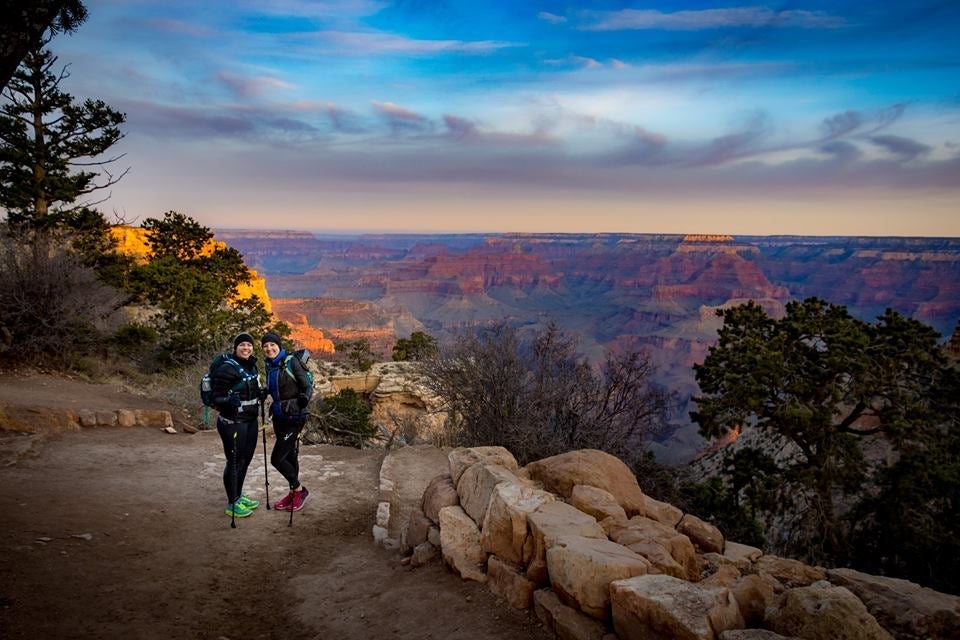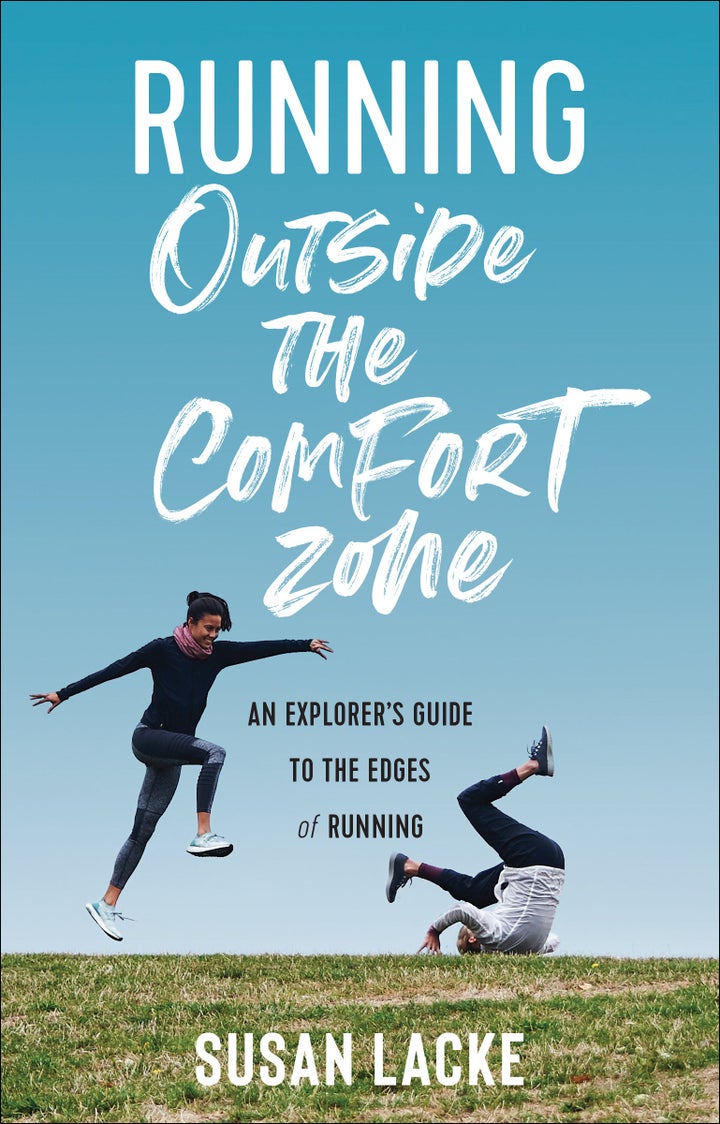Some challenges require a partner in crime. In this excerpt from Running Outside the Comfort Zone author Susan Lacke recounts how the right training buddy can lead to the best running moments.
Standing on the rim of the Grand Canyon, I looked to my left, where Heidi was standing, her eyes wide and unblinking as she read the sign again and again:
GOING DOWN IS OPTIONAL. COMING UP IS MANDATORY.
Below the sign’s block letters were grim statistics from the previous year: 290 search-and-rescue operations, 129 medical helicopter evacuations, 12 deaths.
“You still want to do this?” I asked, nudging her in the rib cage with my elbow to startle her out of her bewilderment.
Heidi took another moment to scan the sign. Slowly, her gaping mouth closed into a smirk.
“Oh, yeah.”
Heidi and I have long joked that the majority of our conversations are some variation of the same two statements: “That’s a horrible idea. What time?” But it isn’t really a joke. For years, we’ve built a friendship on a solid foundation of questionable decision-making and excellent stories.
Like me, Heidi is an endurance athlete. We met on Twitter, in the days when Twitter was mostly just a place where people posted pictures of their cats. For runners and triathletes, however, Twitter was like a massive, faceless cheering squad: Post something about crushing a hill workout or setting a PR at a race, and hundreds (if not thousands) of fellow endurance athletes would shake their virtual pom-poms.
Except Heidi. Heidi wasn’t the cheerleader type. She was more like a whip-cracker, in a good way. When other people offered platitudes, she pushed buttons. If someone spoke in hypotheticals, she told them to stop thinking and start doing. Goading was Heidi’s love language:
“That’s great! What’s next?”
“I bet you could have gone two minutes faster.”
“Why sign up for the half when you can obviously handle the full?”
We lived a thousand miles apart, yet Heidi quickly became one of my favorite virtual training buddies. Whenever I posted something on Twitter about training or racing, I could count on her to say just the right thing, be it inspiration, motivation, or a swift kick in the ass. She always knew what I needed to hear, even when I didn’t know what I needed to hear.
So, when I decided I would run the Grand Canyon on my 35th birthday, I knew exactly whom I wanted to invite.
I called her up and dove right in: “Hey, would it be crazy if—”
“Yes,” Heidi interrupted. “So, what are we doing?”
I laid out my plan: Less than 1 percent of people who go to the Grand Canyon each year make it to the bottom, where the Colorado River twists and turns through the massive rock formations of its own creation. I wanted to know what it looked like down there. I wanted to do something epic for my birthday. I wanted to be a 1-percenter. I wanted to run across the Grand Canyon.
Heidi didn’t hesitate: “That’s a horrible idea. I’ll book my flight right now.”

For many runners, running the Grand Canyon is a bucket-list item, nestled somewhere between the Badwater 135 ultramarathon and the Boston Marathon. But unlike most bucket-list races, the Grand Canyon doesn’t require the runner to pay an entry fee or meet a qualifying standard. You just have to be plucky enough to show up and think you can do it.
And this confidence will be tested many times, even before running across the Canyon. A Google search of “running the Grand Canyon” yields dozens, if not hundreds, of results that all say it’s a terrifically bad idea. For starters, it’s a pretty big hole to traverse: 24 miles across and 6,000 feet deep. The trail, which follows a natural break in the canyon rim, is steep and unstable in parts. Runners have to manage the thin air of altitude at the upper levels and intense heat at the lower levels. There are long stretches with no potable water, requiring runners to carry their own and ration wisely. A bonk or injury in the Grand Canyon can’t be fixed by hitching a ride or using a cell phone to call for help. Anyone who goes down is expected to come back up under his or her own power.
Training for the thing also presents a challenge. It’s such a unique environment that it’s hard to replicate the “upside down mountain,” as it’s known in running circles. Besides, physical fitness is only part of the equation of a successful Grand Canyon run. Upon Heidi and I arriving at the park the night before our big run, a ranger told us about 24-year-old Margaret Bradley, who had died of dehydration while attempting to run across the canyon in 2004. Bradley had finished 31st among women in the Boston Marathon earlier that year, so she certainly had the fitness to do the run. But insufficient water and fuel, coupled with hot temperatures at the bottom (the temperature in the shade that day was 105 degrees Fahrenheit), led to her untimely death.
And that wasn’t all. The ranger proceeded to recite a whole litany of perils runners could encounter on the trails: falls, shifting sands, scorpions, rattlesnakes, excrement from the pack mules that shuttle supplies to the campsite at the bottom of the canyon.
“Donkey poop is dangerous?” I raised a skeptical eyebrow.
“If you’re not paying attention when you step in it, it can be very slippery.”
I searched for a sign of sarcasm. There was none. Donkey shit was a legit concern.
Signs all over the park warned of the perils of venturing past the rim of the canyon. The more we learned of the risk, the more I started to second-guess our plan. The night before our run, while bundled up in a campsite just off the trailhead, I had vivid and terrifying dreams of falling into the canyon. Each time, I’d startle awake moments before hitting the waters of the Colorado River. Just as I finally fell into something resembling sleep, Heidi poked me awake. It was 5:00 a.m. Go time.
We loaded our running packs with water and supplies, our worries seesawing between having too much and not having enough. How could we know what we would need for a day like this?
“Do you think we’ve forgotten anything?” I asked as I worked to zip up a bulging pocket of my pack.
Heidi let out a soft grunt as she slung a full water bladder over her shoulder. “I suppose we’ll find out in the hole. Let’s go.”
We left the campsite just as dawn began to paint the sky with soft pastels. In the 30-degree, crisp morning air, every exhaled breath wafted out in soft white tendrils. At the start of the trail, we encountered the bold-lettered sign warning of the risk of crossing the trailhead: GOING DOWN IS OPTIONAL. COMING UP IS MANDATORY.
“You still want to do this?”
“Oh, yeah.”
It was official: We were going on an adventure. Together, we descended the tight, rocky switchbacks of the trail, each step taking us farther away from civilization. Our cell phones lost reception. We were entirely on our own, but it wasn’t scary—it was exciting. Heidi lifted her arms and started singing “Into the Great Wide Open” at the top of her lungs. Her pure joy—not to mention her passionate attempt at Tom Petty’s nasally singing—made me laugh out loud.
“Sing with me!” Heidi insisted. “No one can hear us!”
We laughed and sang as we descended deeper and deeper into the canyon, eventually losing sight of the rim. As we turned a corner, Heidi stopped suddenly and grabbed my arm.
“Look!” she said with a gasp. Below us was a maze of red-rock mesas, bisected by a bright blue ribbon: the Colorado River. By now, the sun had crested over the top of the canyon walls, unveiling the landscape in all its splendor.

Some time later when we reached the bottom of the canyon, it was already a toasty 90 degrees. We threw off our packs and waded into the river, soaking our legs in the bracing, crystal-clear water. Snacking on sandwiches we had prepped the night before, we let the cool, gentle current massage our tired legs in preparation for the formidable climb ahead. Aside from a few hikers downstream, we had the shoreline to ourselves.
“I can’t believe people go their entire lives without doing this,” said Heidi. She was right. We were breathing in rare air, and we knew it. It felt fantastic. I had been to the Grand Canyon before, but visits had involved squeezing myself into crowded overlooks to get a glimpse of one of the natural wonders of the world. I had perched at the rim, peering down into the layers of pink and brown rock, trying to comprehend its transformation as the river had carved deeper into the stone over millions of years.
As I gazed up at a perfect blue sky, knee-deep in cool water, I thought about those earlier trips. Back then, it had never occurred to me to actually go to the bottom and experience it for myself. Before I took up running, the idea of covering 24 miles, much less up and down precariously steep canyon trails, seemed impossible. Even once I had started running, it didn’t sound much easier. Running the Grand Canyon was something someone else might do, but definitely not me. I had never considered myself the type of athlete who was strong enough to take on such a challenge. That was for the super-fit—the real runners. And yet, there I was, at the bottom of a canyon so vast and so deep I couldn’t see the top rim. I had a perspective of the canyon that few people would ever see. And I had gotten there under the power of my own two legs.
But the secret, I realized, wasn’t in my legs. It wasn’t in my body at all. The secret was sitting right next to me, looking up at that same perfect blue sky framed by magnificent red rock. The reality was, if I had kept this idea to myself, I probably would never have followed through. The reason I was here at all was because I had an enabler of the best kind in Heidi—someone who egged me on, refusing to let me make excuses or play it safe.
My friendship with Heidi isn’t normal. Then again, most runner friendships aren’t. Where most friends would say, “Poor baby,” running friends say, “You’re being a baby.” Where most friends offer gentle encouragement, running friends talk smack. Running buddies celebrate the best, tolerate the worst, and pretend not to notice the embarrassing. They’re a vault for the secrets that we share on the trail, when we’re hungry, hot, and way too tired to be anything but 100 percent real. And when someone asks, “Would it be a horrible idea if . . . ?” the running buddy’s answer is always, “Yes. What time?” A running buddy sees your limitless potential and will happily act as a mirror until you see it, too.
“Ready to go?” Heidi asked, splashing the water playfully and snapping me out of my contemplation. I wanted to stay on that shoreline forever, but it was time to climb—coming up was mandatory after all. We slid back into our socks and shoes, slung our bags over our shoulders, and took off for the top.
Climbing the switchbacks to get out of the canyon offered the same breathtaking views as going down but with significantly more time to appreciate them. It’s slow and steep—some might even call it a slog—and yet every time we stopped to catch our breath, we couldn’t help but look at each other and remark on just how damn cool it was.
As we got closer to the top, we slowly reintegrated into civilization. More and more day hikers began to appear. We passed children licking ice cream cones, and we unabashedly photobombed tourist selfies with our salt-encrusted faces. “Did you do the whole thing?” they asked, taking stock of our dust-streaked faces and sweat-soaked clothes. “Yes,” we said proudly. “We absolutely did.”
“What’s it like down there?” they wanted to know. What’s awesome is that, for the rest of our lives, Heidi and I will be in the 1 percent of people who can answer that question. To be able to wear that distinction is more satisfying than any finisher’s medal.
A pickup truck arrived to shuttle us back to our campsite. We climbed in the bed of the truck and propped ourselves against the back window, feeling the deep fatigue pool into our muscles.
“We did it,” I said. It still didn’t seem real.
“Of course we did,” Heidi replied, putting up a tired hand for a fist bump. “We’re awesome.”
As the truck turned off the main drag onto a dirt road, we took in the view one more time. The canyon looked different now, smaller. I turned to grin at Heidi.
“I think we should do Zion National Park next,” I said. “There’s a 50-mile trail there that—”
“Dammit, Susan,” Heidi said with a chuckle, shaking her head in disbelief. “Can I at least take a shower before you rope me into something else?”
I laughed and put my hands up, nodding in submission. As the truck rumbled down the dirt road, we sat for a while in silent satisfaction, taking in the enormity of what we had just done. Heidi rested her head on my shoulder and sighed.
“Zion, huh? Tell me more.”
Excerpted from Running Outside the Comfort Zone by Susan Lacke with permission of VeloPress.



